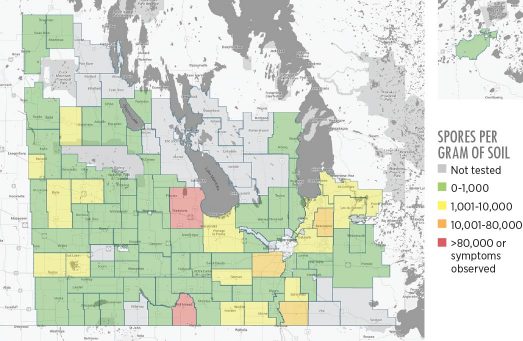PSI Lab tracks clubroot in soil

Detecting soil-borne diseases like clubroot before plant symptoms are visible gives growers time to change management practices before yield loss occurs.
In 2013, two fields in Manitoba were confirmed to have positive clubroot plant symptoms. Previous clubroot DNA concentrations in Manitoba soil samples had been less than 10,000 spores per gram of soil. That’s the threshold required to consistently cause noticeable plant symptoms, says University of Alberta clubroot researcher Stephen Strelkov. So what changed in Manitoba to cause the increase in spores resulting in symptoms in these two fields?
To answer this question, the Manitoba Canola Growers Association (MCGA) and others established a specialized “molecular detection” laboratory called the Pest Surveillance Initiative (PSI). PSI works in partnership with growers, government and researchers to advance discoveries off the lab bench; optimize methodology for molecular level analysis; and provide access to molecular assays not currently offered (due to high costs per sample or a small number of users).
PSI’s first project is to benchmark the current levels of clubroot across Manitoba. Several technical challenges had to be overcome before the more than 400 soil samples collected from growers’ fields could be analyzed.
In order to accurately and consistently detect the low levels of clubroot DNA typically found in Manitoba soils, lab staff had to modify the existing methodology. PSI addressed three areas as part of the sampling project: field sample collection, DNA extraction, and quantification of clubroot DNA.
“Clubroot spores are believed to be transferred during soil movement between fields, so we maintain strict biosecurity practices between fields and between samples,” says Xiaowei Guo, PSI lab director.
The PSI team follows the ‘W’ sampling pattern from field entry and access points as described by the Canola Council of Canada (CCC) and Manitoba Agriculture, Food and Rural Development (MAFRD). Soil from the field is transported to the PSI lab in south Winnipeg and prepared for DNA extraction. Soil is complex and has many DNA-containing organisms in it, so each sample is screened, sieved and finely ground to improve the reliability of clubroot detection.
While time consuming, this meticulous approach provides a high level of confidence that any clubroot DNA present in the sample can be detected. Knowing clubroot is present provides only part of the answer to a canola grower. PSI can also quantify the amount of clubroot DNA in soil. This is important for agronomists, because it is believed that, if clubroot is managed when low levels are present, plant symptoms and yield loss can be avoided. When higher spores per gram of soil are present, more diligent management is required to prevent clubroot from spreading between fields.
Clubroot DNA is reliably quantified using a quantitative polymerase chain reaction (qPCR) assay developed at the University of Alberta*. A “cocktail” of reagents is used in a stepwise manner to ensure only clubroot DNA is detected. Several modifications to the original assay were made to improve the ability to detect clubroot spores at the very low levels of DNA typically found in Manitoba soils.

“Each clubroot DNA analysis we conduct is replicated, and standards of known spore concentration are included with every analysis to ensure analytical proficiency,” Guo says. “These technical modifications have resulted in the ability of the PSI lab to detect as few as 500 spores per gram of soil.”
PSI provides growers with test results along a grid that includes management tips prepared by MAFRD to minimize the spread of clubroot between fields. Results from the bench-mark sampling are updated on the PSI and MAFRD websites at the Rural Municipality level. Cumulative results from sampling indicate non detectable to high levels of clubroot present in Manitoba. As sample numbers increase, aggregate results at the Township-Range level will be displayed on the PSI website.
Facilities like the PSI represent the “next generation” of surveillance for crop pests. Their DNA-based tools provide a powerful early warning system that alerts growers to the problem before crop pests begin to cause visible symptoms. Working with DNA from soil and plant samples opens up other crop-pest combinations for the PSI, such as detection and analysis of herbicide tolerant weed species and tracking pathogen race prevalence. Field level information using advanced technology, coupled with training tools and extension programs, provide growers with the information they need to make informed management decisions. PSI is funded in part by Growing Forward 2.

This map shows where clubroot has been detected in Manitoba.
Lee Anne Murphy is CEO of the Pest Surveillance Initiative (PSI) laboratory in Winnipeg. Find out more about the lab.
*Cao,T., Tewari, J., and Strelkov, S.E. “Molecular Detection of Plasmodiophora brassicae, Causal Agent of Clubroot of Crucifers, in Plant and Soil,” Plant Dis. 91:80-87. 2007.





